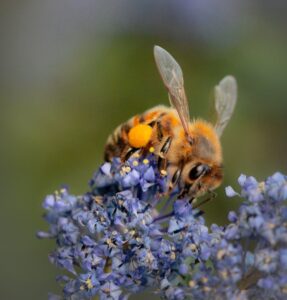As the bee crises continues, we often forget that there are non-native bees and native California bees!
Let’s learn why planting location specific California Native Plants can support California Native Bees!
Did you know, some California bees live alone? Have you seen a yellow-faced bumblebee? DId you know that some California bees only get pollen from a few species of plants?
In California alone, there are about 1,600 species of native bees–and boy are they are diverse! These bees range widely in behavior, color, size, nesting habits, and even social lifestyle. Some native bees, such as the yellow-faced bumble bee are actually better pollinators than honey bees!
Let’s dig into some facts about the most common bee groups found in California. …
Learn more about California native bees from Planet Bee.
How you can help California’s native bees:
Planting native plants in gardens will provide bees with a source of nectar and pollen and will benefit specialist native bees who only feed on specific native plants.
Native plants should be a variety of shapes, colors, and sizes to maintain diversity and attract different native bee species.
Ensure that there is a plant blooming throughout the year because different bee species are active at different times of the year.
Provide more habitat for bees in your yard by reducing lawns and mowing less frequently as well as leaving said green debris on the ground so that ground-nesting bees can make homes.
Refrain from using insecticides, especially neonicotinoids which become absorbed in all parts of the plant and can kill bees or cause them to have trouble foraging and finding the hive.
Provide bees with water by filling a shallow plate with pebbles and water, as the pebbles serve as landing spots for the bees to safely drink without falling in. 70% of solitary bees dig a nest in the ground to lay their eggs and 30% use tunnels in dead trees or logs.
Nesting spaces for solitary bee species can be provided by leaving bare soil unmulched in the garden and keeping dead trees or fallen logs.
Purchase or make a native bee nesting house with replaceable nesting tubes to offer habitat and places for solitary bees to lay their eggs.
Learn more about the economic value of native bees from Planet Bee.

0 Comments